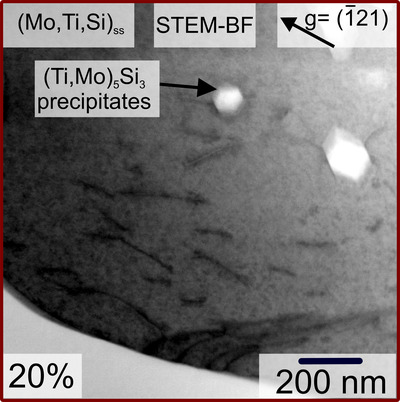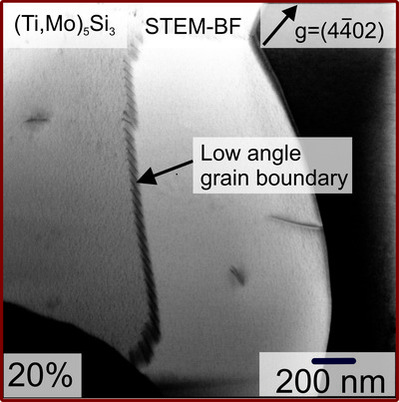Creep-induced microstructural evolution of the eutectic Mo-Si-Ti alloy
Contact Hemanth Thota, Yolita Eggeler
The current state-of-the-art, single-crystal nickel-based superalloys operate close to 90% of their melting temperatures. There is a continuous need to design new materials that can withstand higher operating temperatures above 1100 °C, as higher operating temperatures leads to improved thermodynamic efficiency in the power generation and aerospace sectors [1].
Recently Mo-Si-Ti system has been explored as a potential alternative to the existing high temperature materials because of their high melting temperatures. Among them, the eutectic Mo-Si-Ti alloy showed pesting resistance and good creep behaviour. The alloy has a two phase microstructure with a bcc, molybdenum solid solution (Mo,Ti,Si)ss and hexagonal (Ti,Mo)5Si3 silicide [2].
Compressive creep tests were performed under vacuum at 1200 °C and true stress of 100 MPa to understand the nature of the creep curve and correlate the microstructural evolution processes occurring at micron and nano- scales. The accumulation of creep strain in the two phases in response to the applied stress has to be thoroughly understood.
An attempt is made to identify the dominant creep deformation mechanisms and the active slip planes in both phases. Figure 1a shows numerous dislocations originating from the interface in the solid solution and the interaction of gliding dislocations with (Ti,Mo)5Si3 precipitates. Whereas Fig.1b shows the formation of low-angle grain boundaries in the silicide phase, confirming the occurrence of dynamic recovery. This is accomplished by imaging dislocations in scanning transmission electron microscopy (STEM) mode with selected two beam conditions. STEM energy dispersive spectroscopy (EDXS) is performed to determine the composition of the precipitates in the crept samples.

(STEM)-bright field (BF) images of 20% crept sample
showing a) dislocations in the solid solution

(STEM)-bright field (BF) images of 20% crept sample showing
low angle grain boundary in silicide phase
References
[1] J.H. Perepezko, The hotter the engine, the better, Science 326 (2009) 1068–1069. https://doi.org/10.1126/science.1179327.
[2] D. Schliephake, A. Kauffmann, X. Cong, C. Gombola, M. Azim, B. Gorr, H.J. Christ, M. Heilmaier, Constitution, oxidation and creep of eutectic and eutectoid Mo-Si-Ti alloys, Intermetallics. 104 (2019) 133–142. https://doi.org/10.1016/j.intermet.2018.10.028.
